
Introduction to Paradise – Why the Philippines is a Beach Lover’s Dream
7,641 Reasons to Pack Your Flip-Flops
Have you ever typed “white sand beaches in the Philippines” into your browser and immediately started daydreaming? You’re not alone—and you’re onto something. With more than 7,600 islands, the Philippines offers endless variety, from quiet coconut-lined shores to wild party beaches.
Whether you type best beaches in the Philippines or Philippine beach travel guide, what you’ll find is paradise served up island‑style. The sands are so fine and white, even your flip‑flops will sigh with pleasure. And the oceans? Clearer than your coworker’s water cooler gossip.
From world-famous party beaches to serene, secret coves that even Google Maps has to squint at, this country has every shade of paradise you could imagine. Powdery white sand? Check. Turquoise waters that are so clear you can see your lost sunglasses? Double check. A cocktail in a coconut with a tiny umbrella? Oh, absolutely.
What makes the Philippines so special? For starters, it’s the warmth, both from the blazing sun and the big-hearted locals. Filipinos are known for their hospitality, karaoke prowess, and uncanny ability to turn every beach into a celebration. Whether you’re solo, honeymooning, or escaping with your whole crew, this is the destination that welcomes you like a long-lost cousin with a hammock and a cold drink.
The Allure of White Sand and Aqua Blues
White sand and aqua-blue waters are the combo that turns first-time visitors into lifelong beach converts. The sand’s soft enough to feel like nature’s memory foam; the water shifts from sapphire to turquoise faster than you can say “halo‑halo.” When you write about beaches in the Philippines, the sensory overload is real: sun on your skin, waves on your ears, ice‑cold drink in your hand, and Instagram likes doing somersaults.
Gray beaches are like decaf coffee: they technically get the job done, but nobody’s writing love poems about them. White sand beaches, on the other hand, are the stuff of postcards, proposal photos, and spontaneous happy dances. In the Philippines, the sand is so soft and delicate, it’s nature’s memory foam. You’ll want to roll around in it like a happy golden retriever.
But it’s not just the sand that’ll make you swoon. The ocean here is a real show-off. Imagine dipping your toes into water that sparkles like a glass of bubbly, shifts from sapphire to aquamarine, and is so warm you’ll swear it’s been heated by angels. It’s not just a beach day—it’s a wholly sensory-oriented experience.
Ready to dive in (pun 100% intended)? Let’s explore the best white sand beaches in the Philippines, from the big names to the hidden gems that deserve a spot on your travel wish list.
Boracay – The OG of White Sand Paradise
White Beach and its Instagram Fame
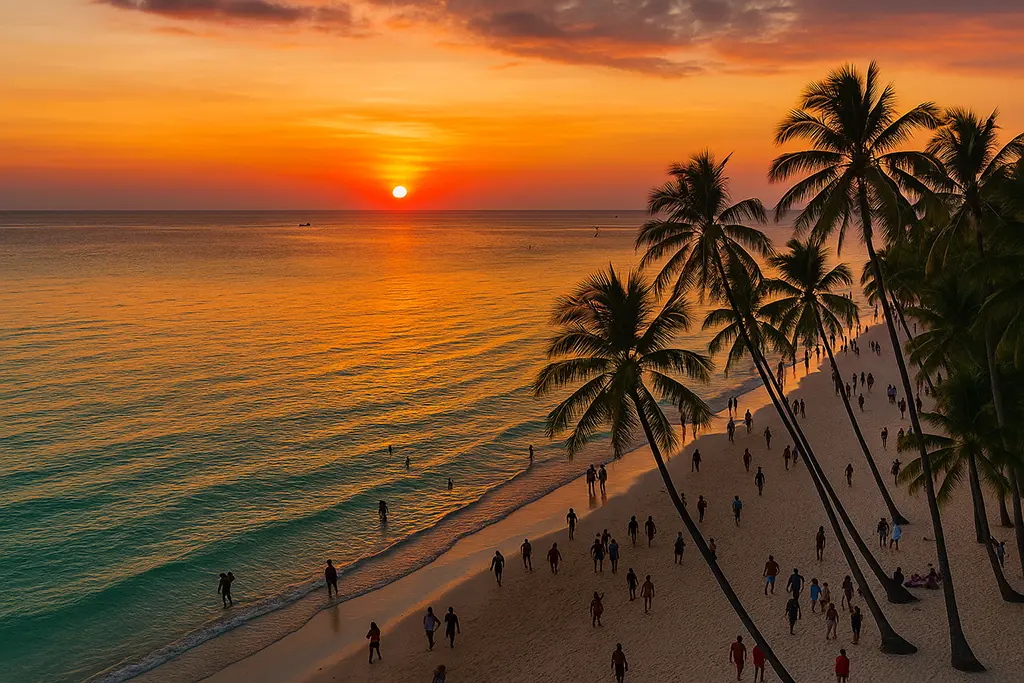
When people search for the best white sand beaches in the Philippines, Boracay’s White Beach is usually top of the list—and rightly so. A 4 km stretch of sweeping soft sand, framed by palm trees, facing sunsets so dramatic they deserve their soundtrack. It’s the beach equivalent of an influencer who’s nailing it every time. Tourists and locals mingle, capture golden-hour selfies, and soak up that “beach vacation in the Philippines” magic.
And yes, it’s popular—but it’s popular for a reason. Walking down White Beach feels like strutting a runway. Tourists from around the globe are snapping selfies, sipping piña coladas, and lounging like sun-soaked royalty. But don’t worry, it’s not all glitzy. There’s still plenty of room to flop down with your towel, build a sandcastle, or accidentally photobomb someone’s honeymoon picture.
Activities Beyond Sunbathing: Because Lying Around Gets Boring (Eventually)
Boracay offers more than just lounging with piña coladas. Into water sports? Try parasailing or stand‑up paddleboarding. Into weird underwater contraptions? Helmet diving awaits. Want a mild adrenaline rush? Banana boating or cliff diving is your jam. And as night falls, the beach transforms into a party space with fire dancers, karaoke beatdowns, and enough good times to justify your travel.
There’s also helmet diving (yes, it looks ridiculous and yes, it’s fun), snorkeling, banana boating, and even cliff diving if you’re into “mild heart attacks as a vacation activity.” And after all that excitement, the beach massages hit differently when they cost less than your lunch back home.
At night, Boracay becomes the lovechild of Ibiza and a beach bonfire party. Fire dancers twirl flaming sticks with unnerving confidence, bars blast reggae and EDM in peaceful chaos, and you’ll probably end up singing karaoke with someone’s lola (grandma). It’s magical, chaotic, and 100% unforgettable.
Palawan’s Hidden Jewels – El Nido and Coron
El Nido: Nature’s Cathedral of Cliffs and Coves
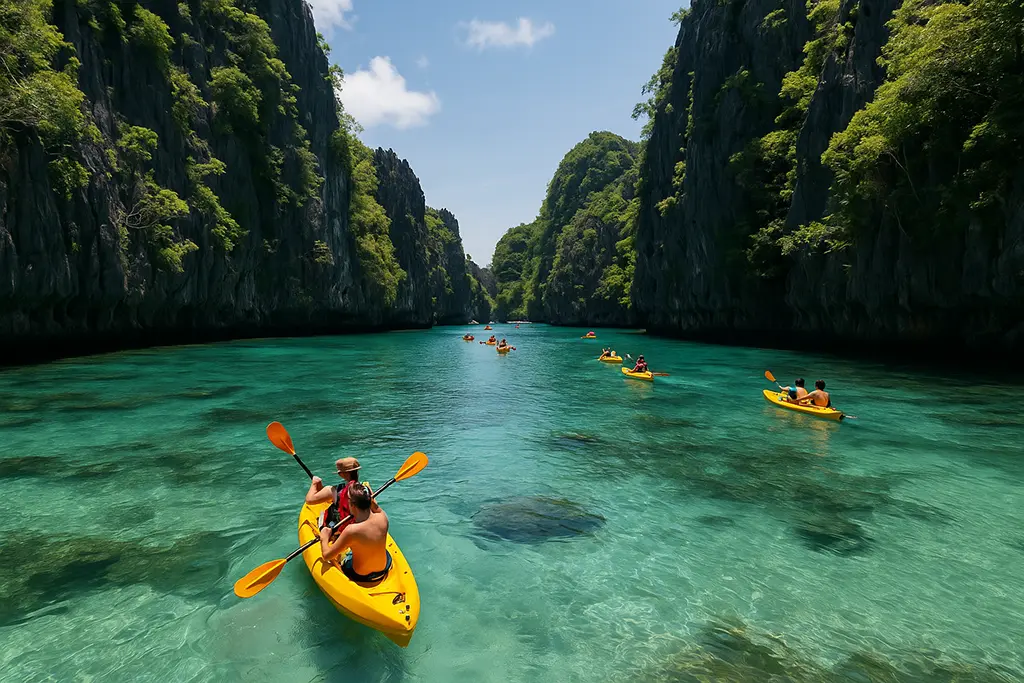
Searching for “El Nido island hopping” content is like clicking into a natural dream. In northern Palawan, towering limestone cliffs rise over crystalline lagoons with names like Big Lagoon and Secret Beach. Island hopping in El Nido (Tours A, B, C, and D ─ are the classics) immerses you in pristine beaches, perfect snorkeling, and photo moments that make every white sand island in the Philippines sound magical.
The beaches here are scattered across hidden islands, each more jaw-dropping than the last. Big Lagoon and Small Lagoon are top hits, but Secret Beach (spoiler: it’s behind a hole in a rock) wins the award for most dramatic entrance. It’s like Narnia, but with more sunshine and less existential dread.
While here, you’ll snorkel with technicolor fish, swim through caves, and find yourself staring at nature in a state of stunned bliss.
Coron: World War II Wrecks Meet White Sand Wonders
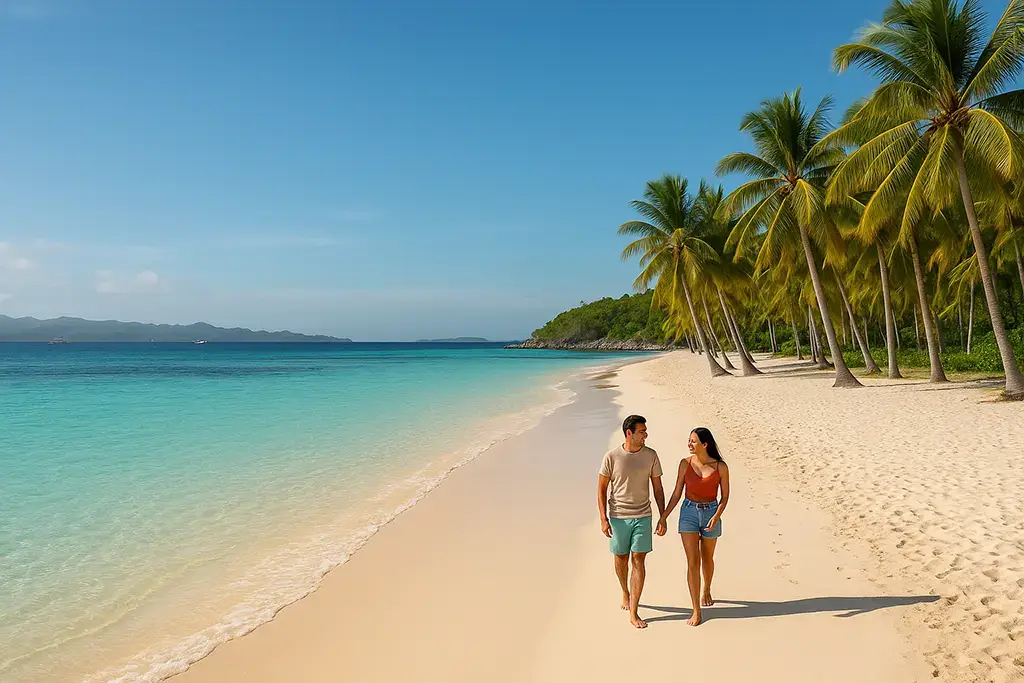
Coron blends history and beauty in one stunning package. Famous for its WWII shipwreck dives, it’s also home to powdery sands at Malcapuya and Banana Island. This place has beautiful beaches in the Philippines and an underwater adventure in one killer itinerary. Prefer tranquility to tourism? The soft sands here offer a quieter stage for sunset gazing or hermit‑crab philosophizing.
But don’t let the war talk fool you—Coron is also a white sand dream. Head to Malcapuya, Banana, or Bulog Dos Islands for soft sands, swaying palms, and the kind of clear water that makes you wonder if it’s been photoshopped. The beaches are quieter here, so it’s perfect for pretending you’re in a shampoo commercial or having a deep philosophical chat with a hermit crab.
Cebu’s Coastal Charms – Bantayan and Malapascua
The Quiet Cousin Who Knows How to Party: Bantayan Island
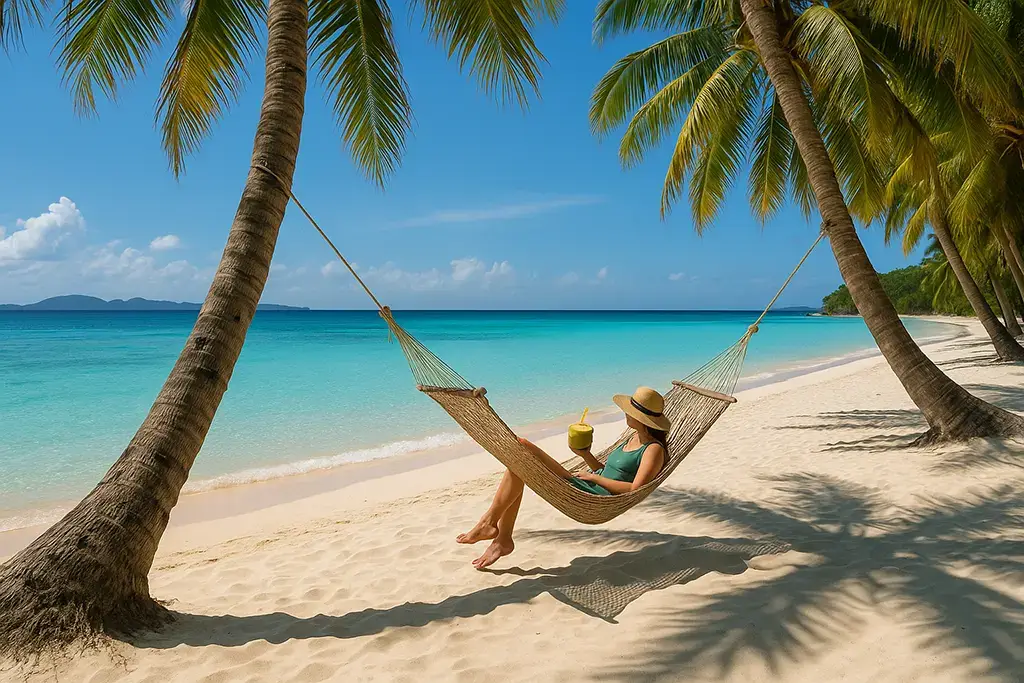
Bantayan Island strikes the sweet spot between budget beach trips in the Philippines and postcard-worthy beauty. It’s relaxed, friendly, and packed with sugar-fine sand. Santa Fe’s beaches are often nearly empty—perfect for mindless snoozing—and the seafood BBQs are so good, your taste buds will file for overtime.
Bantayan Island, just off the north coast of Cebu, is what happens when peace and party have a baby. It’s chill enough to nap on the beach without getting FOMO, but lively enough to offer grilled seafood, fresh mango shakes, and beach bars with surprisingly decent WiFi. The sand? White and fluffy like a marshmallow that’s been lightly toasted by the sun.
Life here moves in slow motion, in the best way possible. You’ll ride tricycles through sleepy villages, wave at smiling locals, and think, “Hey, maybe I could live here and open a coconut stand.”
Malapascua: More Than Just Thresher Sharks
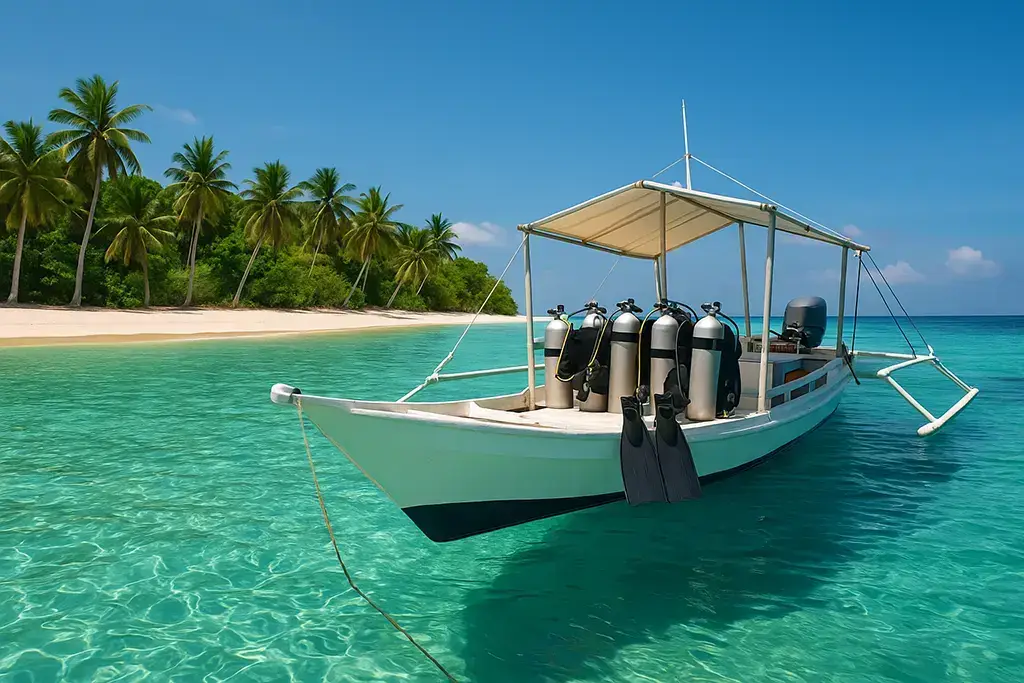
Malapascua is famous for thresher shark dives—this is the world’s only consistent spot for that—but it’s also got shoreline worthy of top islands in the Philippines for tourists. The beaches are pristine, the vibe is chill, and the nights end with mango smoothies and beach bars where umbrellas aren’t accessories so much as a requirement, as long as it’s not Tuesday.
The white sand here is soft and inviting, and the vibe? Think laid-back island life with a pinch of underwater adventure. After a morning of diving with the sharks (don’t worry, they’re friendly introverts), you can spend your afternoon sipping mango smoothies under swaying palms, wondering why you ever thought adulting was a good idea.
And if you’re into low-key nightlife, you’ll love it here. Malapascua’s bars are the kind where the bartender knows your name by your second round—and probably adds an umbrella to your drink just because it’s Tuesday.
Siargao – The Surfer’s White Sand Hideaway
Cloud 9 and the Chill Vibes
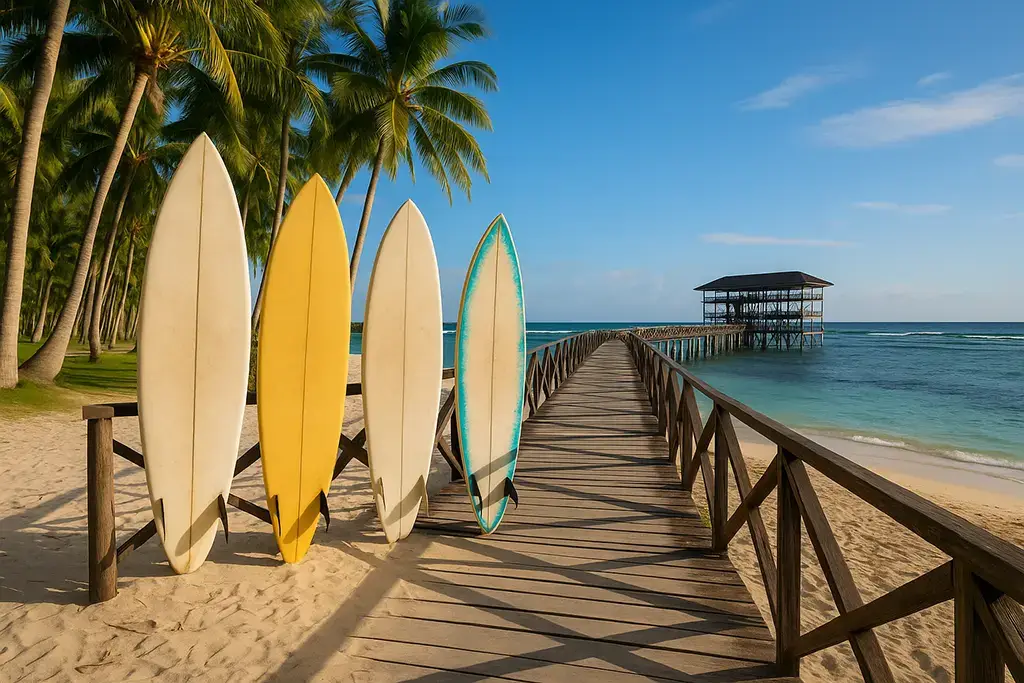
Searching “Siargao surfing spots” paid off—Cloud 9 is legendary. Whether you ride waves or watch wipeouts, the scenery is unbeatable. The white sand shores, the warm water, the friendly locals, and the yoga‑smoothie‑coffee mashup scene make Siargao one of the must-visit beaches in the Philippines. And yes, everyone knows someone who moved here after one visit.
Sure, it’s known for surfing, but even non-surfers can fall in love with Siargao. The beaches? White, vast, and wonderfully windswept. The water? A warm, salty hug. And the people? Chill to the bone. You’ll meet yoga instructors who turned bakers, artists turned coconut farmers, and that one guy who came for a weekend and is now the unofficial mayor.
The food scene is unexpectedly hip—smoothie bowls, vegan burgers, and coffee strong enough to make your soul do a happy dance. Whether you’re watching sunrise from a hammock or sunset from a motorbike, Siargao is where time takes a vacation, too.
Secret Beaches Where You’ll Probably See a Mermaid (Or At Least a Very Tanned Tourist)
Hop on a scooter to find hidden gems like Alegria Beach or Magpupungko Rock Pools. They look lifted from high‑budget visuals with fewer crowds and more space to play. Great for those nights when you search “off‑the‑beaten‑path beaches in the Philippines” and find the unicorn you were hoping for.
Magpupungko Rock Pools (try saying that three times fast) offers tidal pools so clear and blue, you’ll question whether you’re still on Earth or swimming through a Windows wallpaper. And yes, the beaches are sandy and sparkly, and no, there are no actual mermaids—but let’s be honest, with enough sun and San Miguel beer, anything is possible.
Bohol’s Panglao Island – Small Island, Big Vibes
Where Sand Meets Sangria: Alona Beach
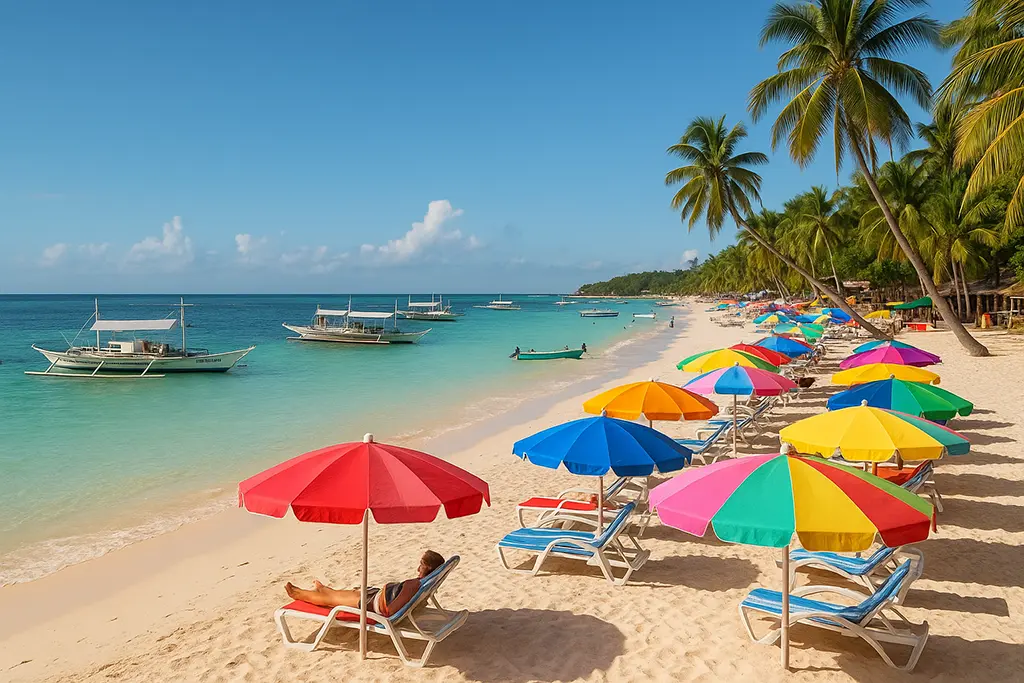
Alona Beach is your go-to if you’re googling “Panglao beach resorts” and craving energy with the sun. It’s a party during daylight, with soft white sand and reef life. At night? Beachside music, seafood BBQs, fire dancers, and enough mojitos to justify skipping tomorrow’s breakfast.
It’s touristy, sure—but in a good way. Think live acoustic music, fresh seafood BBQs, and fire dancers who seem suspiciously immune to pain. Daytime is for snorkeling, diving, and lounging; nighttime is for mojitos and making friends you’ll totally follow on Instagram and never talk to again.
Beyond the Beach: Chocolate Hills and Tarsiers Who Judge Your Life Choices
Because Bohol loves being extra, you’ll also get Chocolate Hills and tarsiers. Chocolate Hills are geological wonders that look like carton‑paper cones gone wild, and tarsiers are tiny primates with big eyes and judging faces. All of this while your beach trip stays firmly in the Philippine beach travel guide hall of fame.
Then there are the tarsiers. These bug-eyed, pint-sized primates look like Yoda and a Furby had a baby. They’re super shy, slightly judgmental, and totally meme-worthy. They live in sanctuaries, where you can marvel at them while they silently critique your wardrobe choices.
In short, Bohol delivers a big adventure on a bite-sized island. Whether you’re paddling through the Loboc River or simply digging your toes into Alona’s sugary sand, this place is a jackpot.
Camiguin – The Island Born of Fire (But Full of Chill)
White Island Sandbar: Now You See It, Now You Don’t
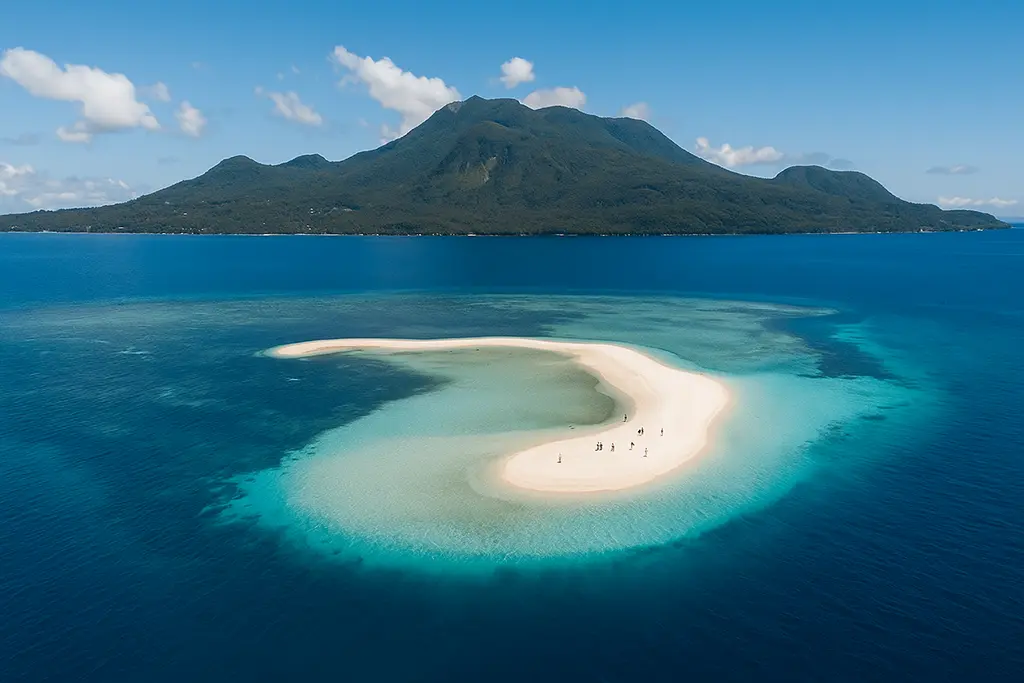
White Island is a shifting sandbar that pops up off Camiguin—best sandbar islands in the Philippines, anyone? It’s pure white sand, no shade, and views of volcano peaks in the distance. It’s minimalist perfection. Just don’t forget your sunscreen; there’s zero shade unless you’re standing under someone else’s hat.
The views here are panoramic postcard perfection, with Mt. Hibok-Hibok looming in the distance like a brooding guardian. Bring your snorkel gear, your best selfie face, and don’t expect a bathroom (Mother Nature doesn’t do plumbing).
How a Volcanic Island Manages to Be a Beach Bum’s Paradise
Camiguin’s volcanic history hasn’t stopped it from becoming a chill island gem. With sunken cemeteries, hot springs, and peaceful beaches, it’s low‑key and local. Writing unique beach experiences in the Philippines? Add this island—foreground: white beach; background: volcanic drama.
Camiguin proves that you can be both hot and chill—literally. It has seven volcanoes, yet it’s one of the most peaceful islands in the country. Here, you can chase waterfalls, soak in hot springs, and marvel at sunken cemeteries (yes, you read that right).
The beaches? Quiet, clean, and kissed by the drama of black volcanic sand and white sandbars. You’ll feel like you’re in an alternate universe where every corner is Insta-worthy, and the locals still greet you with a warm “Kumusta ka?” like you’re an old friend.
It’s a slow island, best explored on a scooter with zero itinerary. Let your GPS take a break—you’re officially on island time.
Samal Island – Davao’s Sandy Secret
Talikud Island: The Name’s Funny, But the Beach is Seriously Stunning
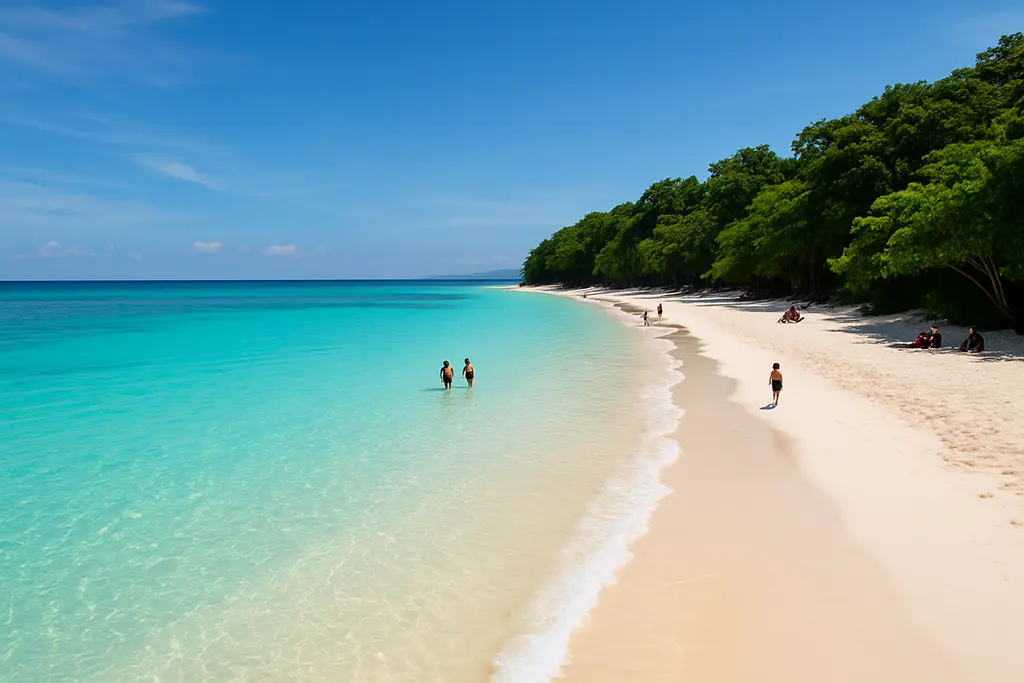
Talikud’s beaches are silica‑soft, the sea is crystal clear, and the locals are friendly. If you’re hunting hidden beaches in the Philippines or craving a snorkel session at Coral Garden, this is your spot. Expect tranquility, occasional chicken crossings, and no chain resorts hogging your view.
Okay, let’s get this out of the way—Talikud Island sounds like the punchline to a dad joke. But giggles aside, this little slice of paradise off Samal Island is straight-up gorgeous. It’s got white sand so soft you’ll want to roll around in it (please don’t—you’ll get weird looks), and waters so clear you’ll consider quitting your job to become a mermaid.
Snorkeling here is top tier, especially at Coral Garden, where the underwater life is colorful enough to rival your childhood sticker collection. And because it’s still under the radar, Talikud remains blissfully unspoiled. It’s you, the sea, and maybe a boat or two. Bliss.
Samal’s Blend of Luxury Resorts and Local Charm
Samal offers everything from casual hostels to upscale resorts. It’s a fantastic budget beach trip in the Philippines destination with style and substance. Sipping mango shakes by day, watching fireflies by a waterfall at night—this place is hospitality with heart (and maybe karaoke).
Davao locals love coming here for weekend getaways, so you know it’s legit. It’s safe, it’s clean, and it’s got everything you need to relax, recharge, and rethink your whole career trajectory.
Zamboanga’s Pink Beach – The Exception to Our Rule
Sta. Cruz Island: When Mother Nature Goes Full Filter
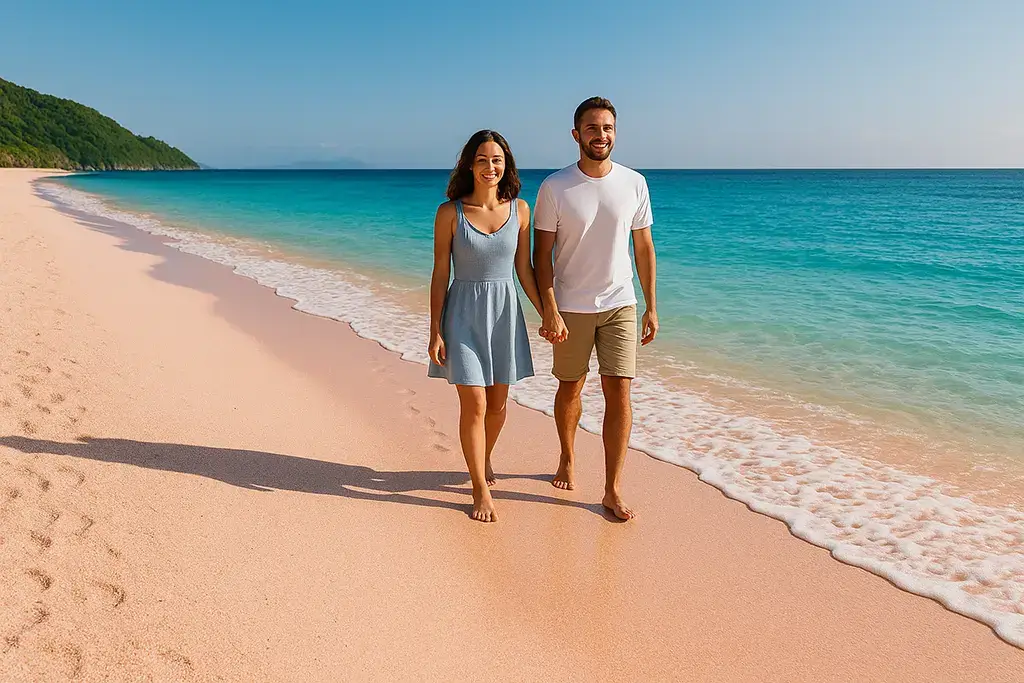
Okay, white sand beaches in the Philippines are legendary—but sometimes you need pink beach Philippines content to stand out. Sta. Cruz Island’s sand is pastel‑pink, made from crushed red coral mixed with white sand. It’s rare, brilliant, and sensational Instagram fuel, plus it’s part of ecological tours that blend beauty with awareness.
The result? A beach so gorgeous, it makes your camera cry with joy. Add turquoise waters, swaying mangroves, and not a chain hotel in sight, and you’ve got yourself an eco-tourism gem that’s as real as it is rare. Plus, because the number of tourists is tightly regulated, you won’t have to fight for space with someone’s portable speaker blasting ‘90s dance hits. Peace, pinkness, and pristine vibes only.
Pink Sand 101: Why It’s Cool and Why You’ll Brag About It
You’ll want to Google pink beach in the Philippines once you know about this place. It’s unique, stunning, and comes with bragging rights. Add kayaking among mangroves and learning local Sama‑Bajau culture, and it’s a top-tier island experience. Seriously, your social feed is going to explode.
So why does everyone lose their flip-flops over pink sand? It’s simple—it’s rare and ridiculously photogenic, and feels like you’re walking on rose petals that got sunburned. Add that to the bragging rights (“Oh, you’ve only been to white sand beaches? Cute.”) and you’ve got yourself a beach trip worth a thousand likes.
But Sta. Cruz Island is more than a pretty face. The surrounding waters are teeming with life, and guided eco-tours let you kayak through mangrove forests, spot rare birds, and learn about local Sama-Bajau culture. It’s educational and aesthetic. Honestly, what more could a beach bum with a conscience ask for?
Tips for Enjoying the Best of the Philippines’ White Sand Beaches
Packing Like a Pro (Because Sunburn is Not a Souvenir)
Let’s play a game: what’s worse than a jellyfish sting, sand in your sandwich, and a hangover on a ferry? Sunburn. That’s why packing right is more than just an afterthought—it’s survival.
Here’s your tropical toolkit:
- Reef-safe Sunscreen (SPF 50+, reef-safe, and no, tanning oil doesn’t count)
- A giant hat (the floppier, the better)
- Sunglasses (bonus points if they make you look like a celebrity hiding from the paparazzi)
- Quick-dry towel (unless you enjoy carrying around a wet burrito)
- A reusable water bottle (hydration = fewer regrets)
- A portable fan (because sometimes Mother Nature turns the thermostat to “oven”)
Don’t forget dry bags for your gadgets, flip-flops that won’t betray you on slippery boat decks, and a power bank—because nothing ruins paradise like a dead phone at golden hour.
Beach Etiquette – Don’t Be That Tourist
We need to talk. Just because you’re on vacation doesn’t mean you should neglect basic manners. So, a few friendly reminders:
- Pick up your trash. Pack out what you pack in; the sand doesn’t need seasoning with snack wrappers.
- Don’t touch the coral—leave nature intact. It’s not a petting zoo. Also, it’s alive and probably judging you.
- Volume control. Your Spotify playlist is fire, to you. Let the sea do the singing.
- Respect local customs. Learn basic Filipino phrases—it wins hearts faster than flash jewelry. You’re a guest. Be the kind that gets invited back.
Enjoy the beaches like your grandma’s favorite couch: look, don’t leave a mess, and please, wear something decent.
Best Time to Visit – Chasing the Sun Without the Storm
Dry Season vs Wet Season: One’s Perfect, the Other is a Mood
For beaches in the Philippines, the dry season (December–May) is your dream window: blue skies, calm seas, no surprises. Wet season (June–November) brings hurricanes, hidden boat delays, and wardrobe decisions based on whether your umbrella can double as a raft. Well… let’s say it’s not ideal for your beach photo shoot. Unless your aesthetic is “windswept and mildly terrified.” That said, if you’re the adventurous type who likes surprise rain and fewer crowds, it’s not all bad.
But let’s be real: if you want powdery white sand under blue skies without the drama of typhoons or mudslides, stick to the dry months. Your sunburned selfies will thank you.
Peak Season Pros and Cons (Yes, There Are Crowds)
From Christmas to May is peak season, which means beaches are buzzing and resorts fill fast. Prices go up. Crowds gather. Sunset seating becomes a competition. But if you happen to visit shoulder months like May or early December, you’ll get mild weather, fewer tourists, and better value. Local festivals might boost the vibe but also costs—choose your excitement wisely.
Want a sweet spot? Try shoulder months like May or early December. You’ll dodge the worst of the rain and the tourist tsunami. Just keep an eye on local festivals—because when Filipinos party, the islands shake (in the best way).
Budgeting for Beach Bliss – Travel Smart, Relax Hard
Affordable Luxury: Is That Even a Thing?
Good news: you don’t need a billionaire’s budget to enjoy the Philippines. Some of the best beaches here are free; nature doesn’t charge entrance fees (most of the time). Accommodation ranges from budget hostels with hammocks and friendly geckos to luxurious resorts with infinity pools and infinity towels.
From nipa hut hostels to beachfront resorts, the Philippines serves up island stays for every budget. Some of the best budget beach trips in the Philippines cost under $30 a night, and the sand still sparkles the same.
Eat local: barbecue, halo-halo, fresh coconut juice. These fill you up, keep you cool, and cost less than a smoothie at a chic café. Spend your extra pesos on island tours, snorkeling gear, and that coconut cocktail you’ll regret nothing about tomorrow.
How to Spend Less on Stuff and More on Sunsets
The secret sauce to saving money in the Philippines is: spend smart, not hard.
- Book early, especially during peak season
- Eat local—trust us, grilled squid beats overpriced pasta any day
- Use apps to score deals on flights and stays
- Skip the tourist traps—ask locals where to go instead
Save on the fluff, so you can splurge on island-hopping tours, paddleboard rentals, and that one cocktail that comes in a pineapple and costs more than your dinner.
Getting Around the Islands – Planes, Boats, and Tricycles
Island-Hopping Like a Local
Navigating the Philippines is like Mario Kart, minus the banana peels (but plus a lot of friendly smiles). Budget airlines whisk you between islands, bangkas (wooden boats) sail coastal routes, and ferry rides offer scenic transport. Pack light—it’ll make hopping from van to tricycle to boat far less painful.
Getting Lost? Let It Happen
The best stories start with “So my ferry was late, and I ended up on an unplanned beach called…”. Getting lost here isn’t a crisis, it’s a new chapter. Locals are warm, directions come with extra snacks, and your selfie game gets better with every unexpected vista.
Here’s the truth: the journey is half the adventure. Your tricycle might break down, your ferry might be “Filipino time” late, and you might end up on the wrong beach (which is still gorgeous, by the way). But that’s the charm of it all.
Getting lost in the Philippines is rarely a disaster—more like a plot twist. Locals are friendly, always willing to help, and they might even invite you to lunch while they point you in the right direction. Who knows? Your best memory might come from a detour you didn’t plan.
The Filipino Beach Culture – More Than Just Sand and Sun
Beach Parties, BBQs, and Karaoke Under the Stars
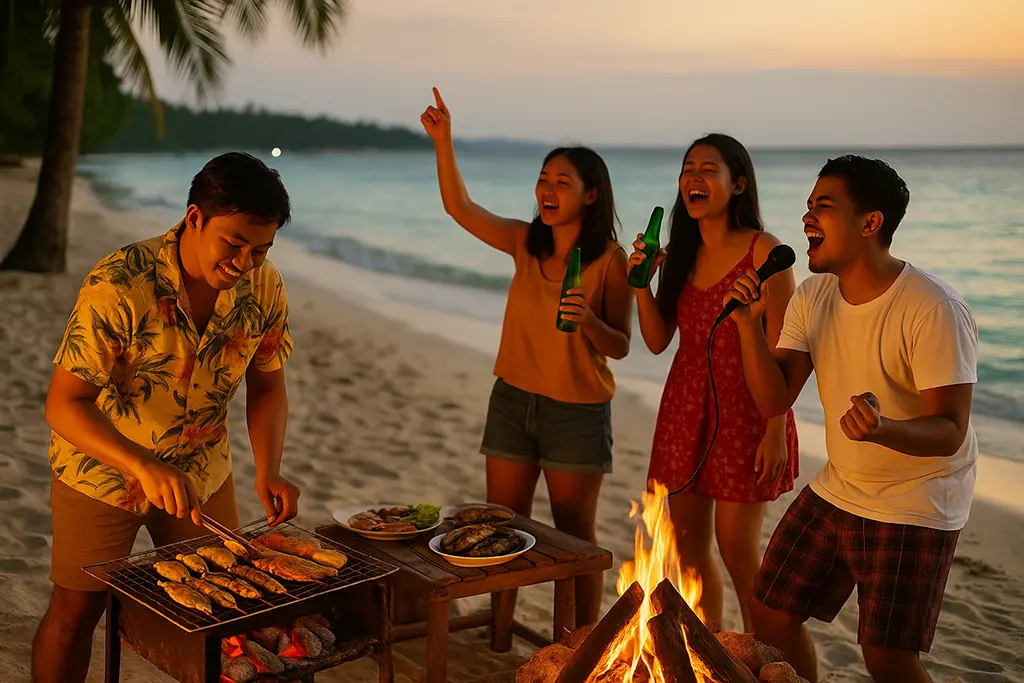
In the Philippines, beach parties are more like beach festivals. You’ll find grilled skewers, fire dancers twirling under the moon, and karaoke that makes fish swim in formation to listen. It’s generous, loud, and you’ll be expected to sing along—or at least applaud loudly.
Filipinos love the beach almost as much as they love feeding their guests. Expect BBQs with skewers of everything (pork, chicken, squid, mysterious delicious things), tubs of ice-cold Red Horse beer, and impromptu karaoke sessions powered by portable speakers and boundless enthusiasm. Yes, someone will belt out a power ballad, and yes, you will be expected to join in.
Don’t be surprised if a casual beach day suddenly turns into a birthday party, a christening, or even a wedding. That’s just how island life rolls—spontaneous, generous, and louder than you expected.
Hospitality with a Side of Halo-Halo
The Filipino hospitality is legendary, and it shines brightest by the sea. You’ll get invited to eat, offered rides to nearby beaches, and possibly be adopted by a local family if you show even a mild interest in karaoke or lechon.
But let’s talk about halo-halo. It’s the unofficial dessert of Filipino summers, and the name means “mix-mix.” Why? Because it’s a chaotic, colorful, delicious mess of shaved ice, sweet beans, flan, purple yam, and whatever else someone had in the pantry. It looks like a unicorn sneezed in a glass—but it tastes like pure tropical bliss.
Between the warmth of the people, the chaos of the celebrations, and the joy of communal meals eaten with sandy hands, you’ll leave the Philippines with more than just tan lines. You’ll take a piece of the culture with you (and possibly a few extra pounds).
Conclusion – Finding Your Slice of Sand-Sational Heaven
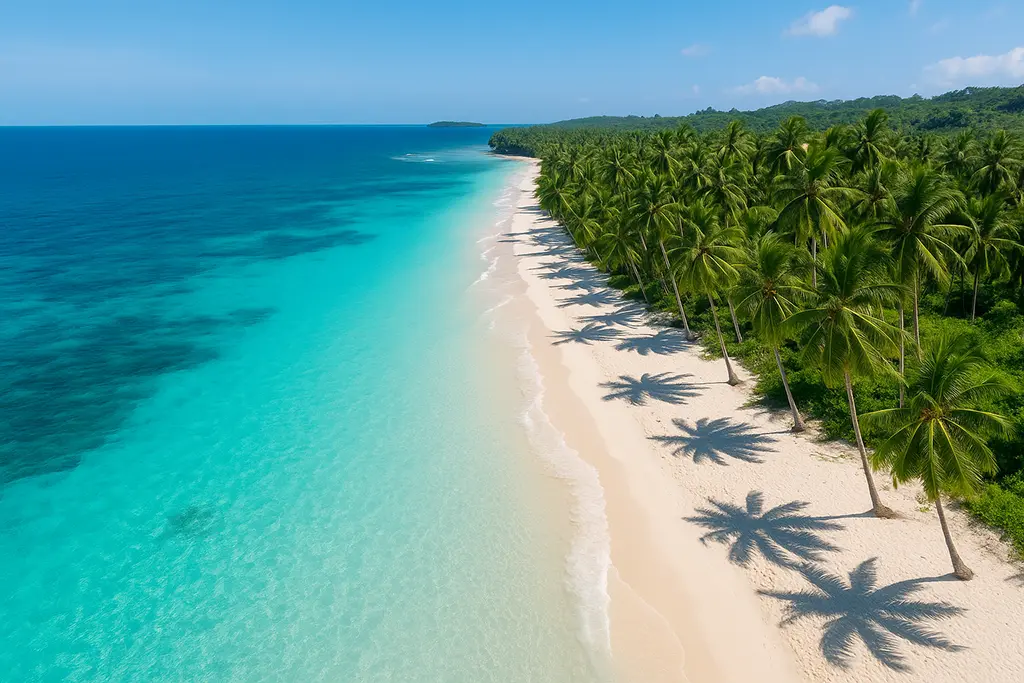
When you type “white sand beaches in the Philippines” or “best beaches in the Philippines,” you’re tapping into real paradise potential. From Boracay’s high-energy shores to El Nido’s postcard lagoons, from Malapascua’s shark-filled waters to Siargao’s surfer scene—this nation is choosing your beach adventure classic.
Whether you’re in it for the sunsets, the snorkeling, the silence, or the singing grandmas, you’ll find your paradise—and then wonder why you didn’t come sooner. This archipelago is the definition of “spoiled for choice,” and every beach, no matter how remote or famous, offers its flavor of chill.
Just pack your flip-flops, charge your camera, and prepare for sunburns, serendipity, and a severe case of “Why don’t I live here?” Because the Philippines doesn’t just offer beaches—it provides a whole new state of mind.
FAQs
1. What is the best beach in the Philippines for first-time visitors?
If you’re new to island life, Boracay’s White Beach is your safe, sandy starter pack. It’s got everything: powdery sand, clear water, activities, nightlife, and enough food options to make you forget your diet ever existed.
2. Are the beaches in the Philippines family-friendly?
Absolutely. Places like Panglao (Bohol) and Samal Island are perfect for families—calm waters, shallow shores, and activities for all ages, from snorkeling to sandcastle domination.
3. Do I need a visa to visit these islands?
Many nationalities get a 30-day visa-free stay upon arrival, but always double-check with immigration or your local embassy. And bring a pen—those arrival cards don’t fill themselves out.
4. What should I pack for a beach-hopping trip in the Philippines?
Pack light, smart, and waterproof:
- Swimsuits (at least two—you’ll live in them)
- Flip-flops and reef shoes
- Dry bag
- Reef-safe sunscreen
- A sarong (fashion meets function)
- A portable fan (your new best friend)
5. Are there vegetarian or vegan food options on these beach destinations?
Yes! While the Philippines is a land of meat skewers and seafood, many islands now cater to vegetarians and vegans, especially in touristy areas like Siargao, El Nido, and Boracay. Think veggie stir-fries, coconut-based curries, and fruit platters that’ll put your Instagram on fire.
Other Articles that may be of Interest
You may also find the following articles interesting.
- Inside the Colorful Heart of Filipino Heritage
- The Ultimate Nightlife Guide to the Philippine Islands
Suggestions For Lodging and Travel
Lodging is widely available throughout the Philippines. However, you may want to consider getting assistance booking tours to some of the Philippines’ attractions. I’ve provided a few local agencies that we’ve found to be very good for setting up tours. For transparency, we may earn a commission when you click on certain links in this article, but this doesn’t influence our editorial standards. We only recommend services that we genuinely believe will enhance your travel experiences. This will not cost you anything, and I can continue to support this site through these links.
Local Lodging Assistance
- Guide to the Philippines: This site specializes in tours throughout the Philippines, offering flexibility in scheduling and competitive pricing. I highly recommend them for booking local arrangements for a trip like this one. You can book flights and hotels through the Expedia link provided below.
- Hotel Accommodations: I highly recommend The Manila Hotel for a stay in Manila. I stay here every time I travel to the Philippines. It is centrally located, and many attractions are easily accessible from there. Intramuros and Rizal Park are within walking distance. I have provided a search box below for you to use to search for hotels (click on “Stays” at the top) or flights (click on “Flights” at the top). This tool will provide me with an affiliate commission (at no additional cost to you).
- Kapwa Travel is a travel company focused on the Philippines. It specializes in customizing trips to meet customers’ needs.
- Tourismo Filipino is a well-established company that has been operating for over 40 years. It specializes in tailoring tours to meet customers’ needs.
- Tropical Experience Travel Services – Tours of the Philippines: This company offers a range of tour packages, allowing you to tailor your trip to your preferences.
Lastly, we recommend booking international travel flights through established organizations rather than a local travel agent in the Philippines. I recommend Expedia.com (see the box below), the site I use to book my international travel. I have provided a search box below for you to use to search for flights (click on “Flights” at the top) or Hotels (click on “Stays” at the top). This tool will provide me with an affiliate commission (at no cost to you).
Living your best life Rich! Glad to see it.
Hi Fred,
It’s good to hear from you. I am trying to Live my Best Life now. In fact, I’m heading back over to the Philippines next Monday for a three month visit need to get away for the winter). So, what do you thing of my blog? I’m finding that I actually like writing and it keeps me occupied. I’ve now reached a point where I’m trying to post a new article every week and it’s starting to pay off. I’m seeing more traffic and I’ve actually had a few people use my referral links so it’s helped to cover the cost of the site.
Anyhow, hope all is going well for you. I have been keeping in touch periodically with Lisa and the last I heard, it sounded like all was going well.
Rich